Home | Front Page | Blog | Index | New | Contact | Site Map
![]() Japan
Japan
![]() Nagoya
Nagoya
![]() Takayama
Takayama
![]() Gifu
Gifu
![]() Kanazawa
Kanazawa
![]() Kyoto
Kyoto
![]() Shikoku
Shikoku
![]() Henro Pilgrimage
Henro Pilgrimage
Cherry Blossoms
Shrines and Temples
Museums
Bicycling
Kabuki Theater
Food and Lodging
Shibuya
Shinjuku
Yokohama
Narita Town

Travel 2008
Australia
Britain
Paris
Basel
Berlin
Travel 2007
Sydney
Paris
Britain
USA
Canada
Australia 2007-08
Travel 2006
Greece
Turkey
Thailand
Malaysia
Indonesia
Singapore
Travel 2005
Berlin
Paris
Moscow
Russia
Athens
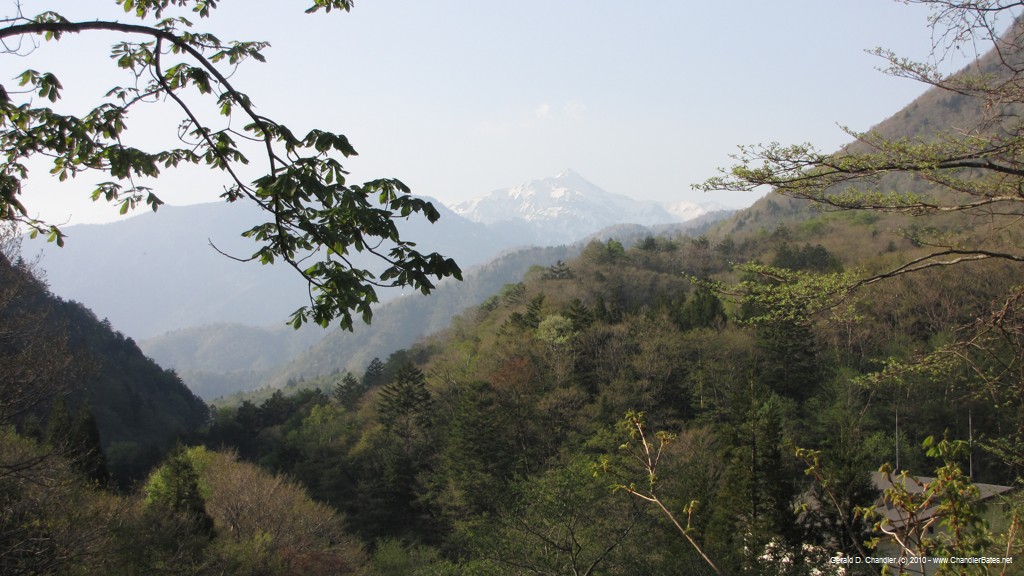
Japanese Alps seen from Hirayu |
There are two classic excursions from Takayama into other parts of Gifu Prefecture. By "classic" we mean the sort of day trips that hotel concierges and tour bus companies will try to sell you. Their trips cost double and triple what it would cost you to do yourself, but for the big bucks you get comfort, certainty, don't have to navigate (much) a foreign language, and a generally rushed feeling. We opt for the opposite: do-it-ourselves, discover and interact with the natives, save money, and sometimes never get to our goal. At least we have plenty of time and can try again the next day.
So that is how we went one day to Hirayu and its high hinter land, Shinhotaka , to the east of Takayama, almost out of Gifu, to see an onsen resort and a snowy, ski region of Japan. Two days later we went to the opposite edge of Gifu, to its western mountain border with Ishikawa, and made a rushed visit to the preserved traditional village of Ogimachi. Ogimachi is a part of Shirakawa, a large complex of gassho-zukuri farmhouses.
Hirayu and Shinhotaka
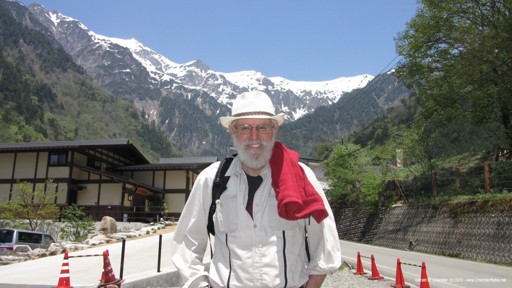
Getting ready for ascent |
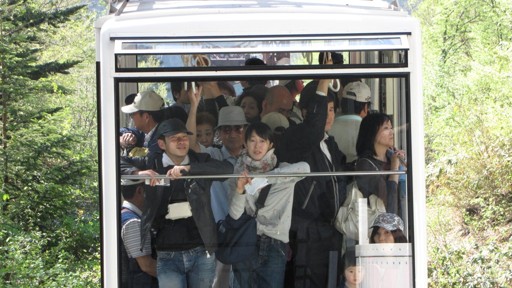
Ropeway to Shinhotaka |
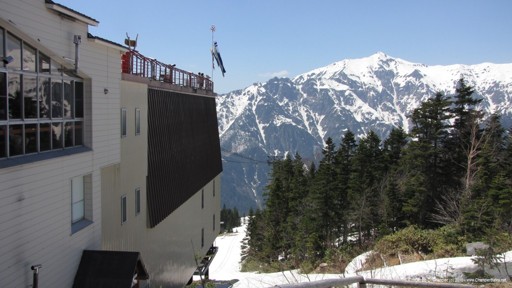
Shinhotaka Ropeway Station |
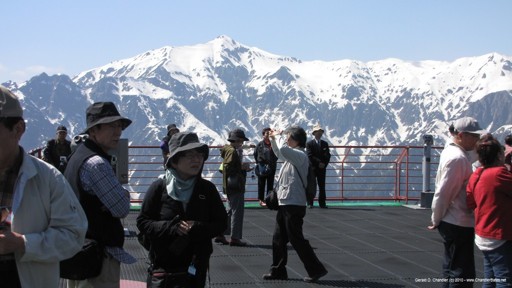
Shinhotaka Summit |

Ice records our names |
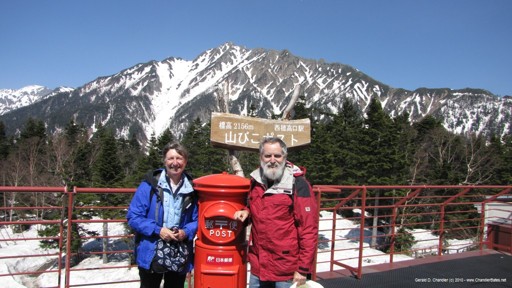
At the summit between crowds |
In Takayama it was easy enough to find the right bus to Hirayu: As in most of Japan the bus and trains share stations and we'd been at the bus station when we arrived by bus from Nagoya and been left off in what we thought of as the train station parking lot. Our ride to Hirayu was easy and took about an hour; there we had to change bus for Shinhotaka. In Hirayu there must be two dozen or more hotels, big and tiny, that cater to those who want to relax in the hot mineral waters of an onsen. Some people that we later met in Vienna, were big onsen fans and liked nothing better than taking off from Nagoya (where they live) and spending the weekend at an onsen up here in the mountains. We thought it better to get up into the (cold?) mountains while there was plenty of daylight; if we hadn't settled into an onsen up in the mountains then on the way back to Takayama we could, if we liked, pick a hotel or public (independent of hotels) bath. As it happened, on the return we were happy enough just to look around Hirayu. The next day we learned that one fellow who had disappeard from the Zenkoji for two days was back and we learned he'd spent two pleasurable days in the mineral waters of Hirayu. Perhaps next time for us.
Having changed bus we had a pleasant ride along a curvy mountain road and in 30 minutes were in Shinhotaka. We were — as usual it would seem — confused as to how to proceed next. But we found some help and headed for what is called the ropeway but in reality is a steel-supported cable car that takes you from the valley floor, at about 500 meters to the summit, at about 2100 m, in two stages. Going up and even more so at the top we got fantastic views of snow-capped mountains all around as well as snow on the ground (see the photo of our signatures carved into a wall of snow!) We'd like to have hiked up, or at least down, but Gerry's leg would have been ruined by it.
At the bottom it had been sunny and warm; at the top we had to put our coats on and zip up. It was then that Gerry realized that he no longer had his red fleece (see picture; it's on his shoulder). At first we guessed it had been left either in the bottom or the middle station. The helpful folks at the top searched the top and called the two lower stations to no avail: not found. On the way up we had not tried to catch the first cable car and had stopped in the most luxurious hotel to see what it was like (very, very nice); could Gerry have left his fleece there? Before going to the bus we called in and were very graciously given the fleece. (It has since done lots of valuable duty; he's wearing it now as he types these words.)
Ogimachi
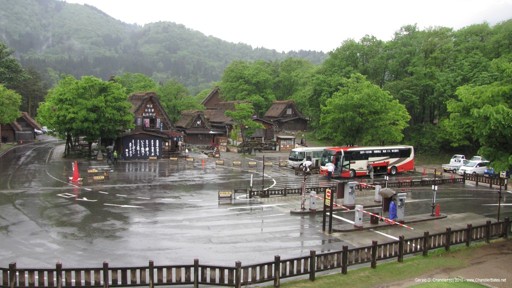
Ogimachi Bus from Bridge |
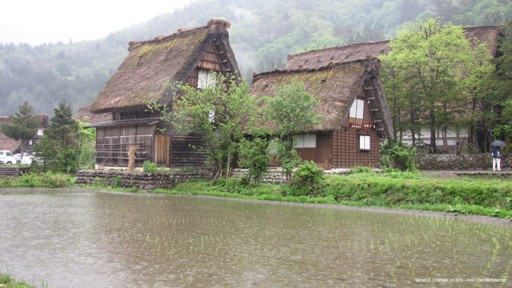
Gassho-zukuri farmhouses |

Houses are old; life is modern |
We almost didn't make it to Ogimachi and its 250-year old and well preserved gassho-zukuri farmhouses. On the one hand, they seemed quite interesting; on the other we asked ourselves if we needed to see more that the 32 we had seen at Hida-no-Sato folk village, which is within walking distance of the center of Takayama. Since the Takayama tourist office was very helpful and gave us maps and time tables of the buses that could take us there we did consider it but in the end it didn't seem worth the expense and trouble of going and coming back. (And, if we'd had a third hand, we'd note that Takayama kept us busy enough without taking day trips.)
Because our guides didn't list any affordable accommodation there we didn't want to spend the night. We did know that Ogimachi was about midpoint to our next stop, Kanazawa and that if we did things right we could take an early morning bus, spend about three hours there, and catch an afternoon bus on to Kanazawa. Not — as we found out. Our outgoing bus left from a different station, Shirakawa (presumably nearby), than our incoming bus arrived at so we would have to trundle our bags from one to the other. We didn't want to rely on that. So we elected for the direct bus to Kanazawa and caught it with no trouble. Imagine our surprise to find that our bus would have a 45 minute layover and that we were within hundreds of meters of Ogimachi.
Gerry was delighted. Jan, unlike Gerry, is perceptive and noticed, with her acute perception, that it was raining. We quickly agreed that Jan would watch the bags in the tiny shelter that served as a bus station while Gerry went off to photograph. By the time we collected our bags and got to the bus station, all of the seats in the tiny waiting room were taken, but Jan smiled as Gerry went off, not bothered because Hida no Sato in Takayama had been enough for her. Gerry was rushed but he had just about enough time to walk every village street and get lots of photos of the thatched-roofs. He indeed was hampered by the rain, trying to protect his camera with his unstable umbrella, but it was worth the effort. Now, having seen Gerry's photos, Jan finds that grassho are a bit more impressive in situ in a real village.